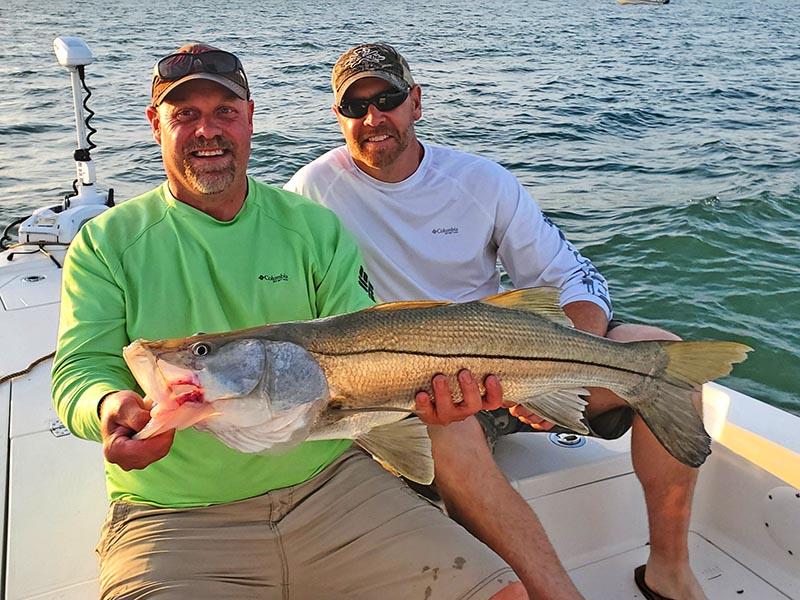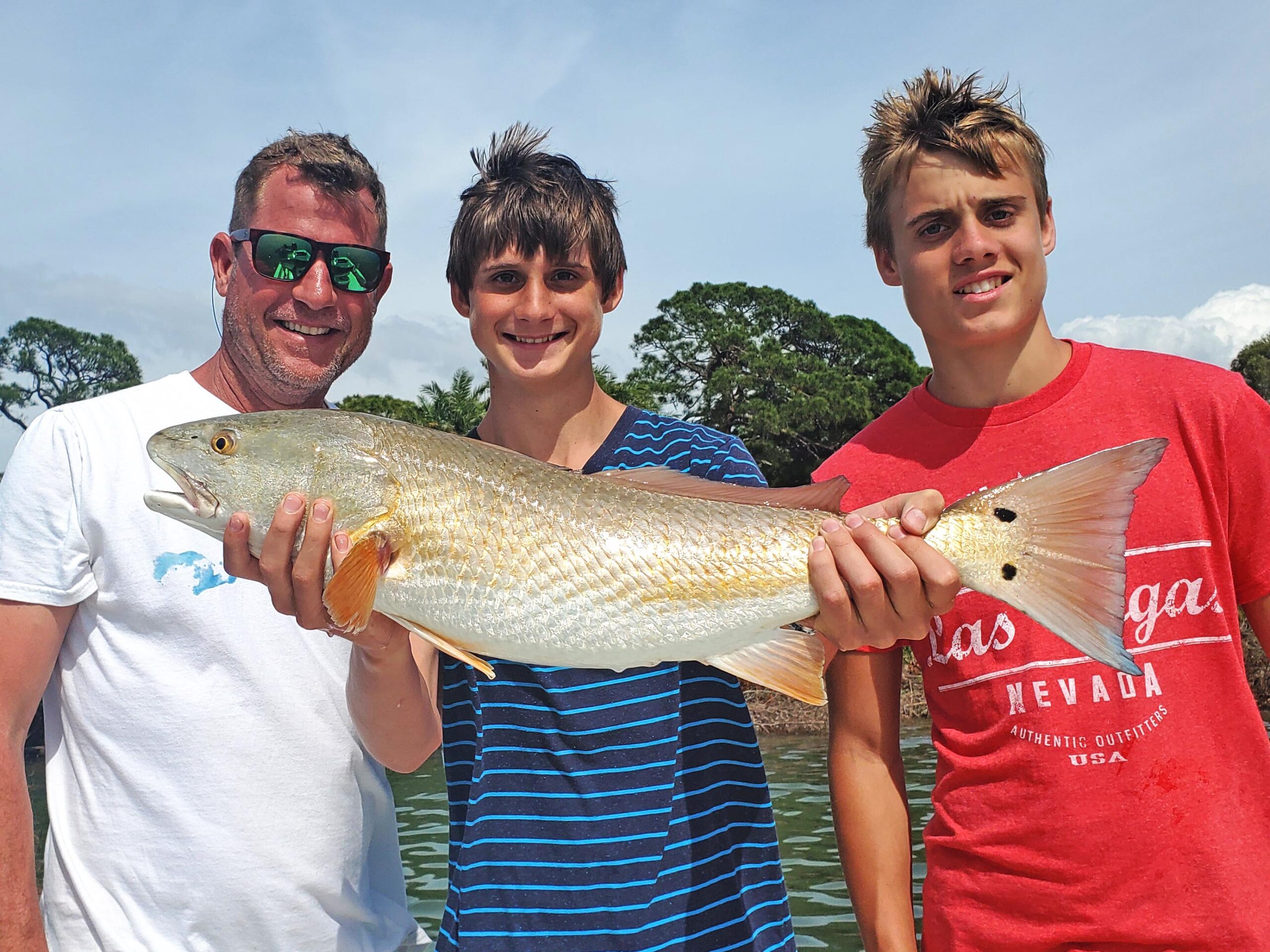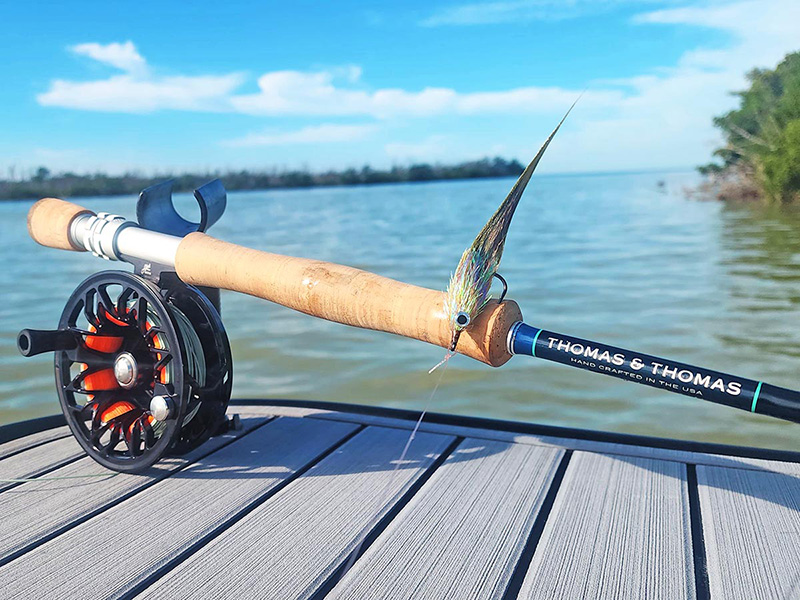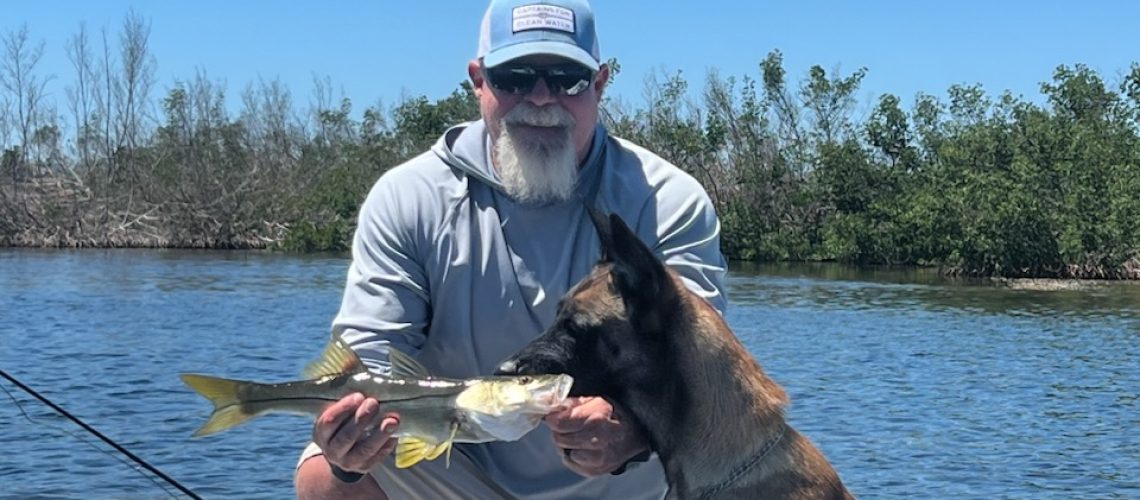When February rolls around and spills into March, we hit a sweet spot in the Everglades—what some fishermen call the Spring Kickoff. It’s that in-between stretch where winter’s grip starts to loosen up, water temps creep back up, and the fish start waking up hungry. If you want to go after snook, tarpon, and redfish in one of the most untamed, fish-filled places in Florida, this is the time to start booking those Everglades fishing charters.
If you’re ready to sneak through the mangrove tunnels, work the Gulf-side flats, or push deep into the backcountry creeks, the bite is on. Let’s go over some tips for targeting these fish this time of year so you know what to expect when you’re out here in the River of Grass, chasing the big three.
Snook Fishing in the Everglades – February-March Game Plan
Snook are some of the most temperamental fish in the Sunshine State—and when it’s cold, they get lazy. But by late February and into March, that starts to change. The water warms up just enough to pull them out of the deepest holes and back into their ambush spots along mangrove shorelines, creek mouths, and oyster bars.
Snook are highly temperature-sensitive, which is why February and early March can be unpredictable. They become sluggish when water temps dip below 60°F, but once things start creeping past 68°F to 70°F, their metabolism kicks back in, and they begin actively feeding.

During a cold front, snook will often hold tight to deep holes in rivers, channels, or residential canals, where water temperatures remain more stable. As soon as a warming trend settles in, they begin migrating back to the shallows, posting up around mangrove roots, undercuts, and submerged structure.
A good trick? If you’re snook fishing and find one in a warm pocket of water, there are likely more nearby. These fish group up in predictable patterns, meaning once you dial in on a productive spot, you can often pull multiple fish from the same area.
Where to Find Them
- Back bays & deep creeks – These spots hold heat, and snook stack up here when it’s chilly.
- Mangrove edges & creek mouths – Once the sun’s been up for a while, they slide into shallower ambush points.
- Flats & oyster bars – By March, on warmer days, they start pushing onto the flats, looking for an easy meal.
Baits & Tactics
- Live bait: Pilchards, shrimp, or finger mullet work wonders.
- Lures: Soft plastics on a jig head, paddle tails, or topwater plugs (especially in the morning).
- Fly fishing: Small baitfish patterns work well when the water’s clear.
On a good day, you can find snook stacked up in hidden creeks, blowing up bait like it’s summer. On a cold front, you’ll have to slow it down—bounce a jig off the bottom and be patient.
Ideal Weather & Water Conditions for Snook Fishing Trips
- Outgoing tides are generally best since snook love to ambush bait that gets flushed out of creeks and estuaries.
- Wind-protected areas are often key because snook like to stay in spots where they can ambush prey without fighting heavy current or waves.
- Midday & afternoon warmth can be the difference-maker, especially after a chilly morning. Look for dark, muddy bottom areas that hold heat.
If you’re out on a charter boat with a fishing guide, they’ll often plan trips around these conditions, positioning you at the right creeks and back bays based on the tides and temperatures. If you’re fishing on your own, be ready to adapt throughout the day—what worked at sunrise might not be the move by lunchtime!
Tarpon in the Everglades – Rolling Silver in the Spring Kickoff
Let’s talk Everglades tarpon fishing…

If you’re looking for a fight, there are plenty of tarpon to target in the Ten Thousand Islands, backcountry rivers, and deep Everglades channels around February and March. In February it’s mostly (but not all) resident tarpon (10–50 lbs) in backcountry creeks, rivers, and deep channels. Larger fish start appearing in March if the weather warms early.
Tarpon are one of the most temperature-sensitive species in the Everglades, and their migration and movements in February and March depend on water temps and weather patterns.
- When winter temperatures dip below 72°F, tarpon tend to hibernate in deep holes, rivers, and canals where water temperatures are more stable.
- On warming trends—especially when afternoon highs push into the upper 70s—they become more active and begin rolling in the mornings and evenings.
- Juvenile tarpon (10–50 lbs) stay in backcountry rivers, deep mangrove creeks, and residential canals all winter, while larger fish (80–150 lbs) start showing up more consistently in Gulf passes and coastal cuts in March.
Tide is a major factor. Tarpon feed best during moving water, whether it’s incoming or outgoing. The best bite often happens at first light or right before sundown, when they are most active and willing to hit surface baits.
Where to Find Them
- Backcountry creeks & rivers – Juvenile tarpon love hanging in the warmer, deeper cuts.
- Canals & deep holes – These spots hold heat and bait, making them a prime hangout.
- Coastal Everglades & Gulf passes – When March rolls in and things warm up, bigger fish start moving in from the Gulf.
Unlike snook or redfish that hold tight to structure, tarpon move throughout the water column—so adjusting your presentation makes a big difference.
- When tarpon are rolling on the surface, work a slow-sinking lure, free-line a live mullet, or use a floating fly that stays just under the surface.
- When they’re holding deeper in creeks or canals, try a DOA Bait Buster, heavy jig, or live bait on a weighted rig to reach them.
- If they’re in murky water, scent plays a big role—consider adding menhaden oil to soft plastics or using a cut bait like ladyfish.
Baits & Tactics
- Live mullet or pinfish – Always a go-to for bigger tarpon.
- Artificial lures – DOA Bait Busters, paddle tails, and even jerkbaits work well.
- Flies – Black and purple patterns in stained water, white and chartreuse when it’s clear.
If you hit it right, you can find tarpon rolling in glassy backcountry waters early in the morning, just waiting for the right bait to cross their path. Some days, they’re just lazy, barely sipping bait off the surface. Other days, they’ll explode on a well-placed lure like a freight train.
Best Weather & Water Conditions for Targeting Tarpon
- Low wind, calm water – Tarpon roll and feed more aggressively when the water is slick, making early mornings a prime time.
- Incoming tide – Warmer water pushes in, bringing baitfish and getting the tarpon more active.
- High barometric pressure after a warming trend – A stretch of stable, warm weather (3+ days of steady temps) will get fish moving more predictably.
If you’re fishing with a guide, they’ll watch these conditions closely to put you on the best fish at the right time. If you’re going solo, timing your trip around a warming trend and good tides will greatly increase your chances of a catch.
Redfish – The Most Reliable Bite of the Three
Unlike our local snook and tarpon, which can be sluggish after a cold front, redfish stay active year-round, even when the temperature dips. Redfish don’t care if it’s windy, overcast, or cooling off after a front—they’re still out there bulldozing through oyster beds, cruising the shorelines, and tailing on the flats.
During February and early March, redfish often stick to deeper creeks, channel edges, and oyster bars, where the water retains heat. As the month progresses and water temperatures push into the 70s, they start moving into flats, sandy potholes, and shallow bays, where they actively hunt for crabs, shrimp, and small baitfish.

One of the best things about targeting redfish in the Everglades, 10,000 Islands, and Florida Bay during the Spring Kickoff is that they’re predictable. Unlike snook, which are highly temperature-dependent, or tarpon, which are often hit-or-miss, redfish stay in the same general zones and follow repeatable patterns.
Where to Find Them
- Mudflats & oyster bars – Redfish dig around for crabs and shrimp in these spots.
- Shallow bays – On a warm afternoon, reds will push up into knee-deep water looking for food.
- Creek mouths – A great ambush point, especially on a moving tide.
Best Baits & Tactics
- Live bait: Shrimp, cut mullet, or pinfish get them fired up.
- Lures: Gold spoons, weedless soft plastics, or topwater lures early in the morning.
- Flies: Crab and shrimp patterns work great in shallow water.
By March, redfish get more active, pushing up into the flats in bigger schools. If you find one, there are usually more, so stick around and work the area thoroughly.
Best Weather & Water Conditions for Catching Redfish
- Cloudy or overcast skies – Redfish feel more comfortable moving onto the flats when there’s less direct sunlight.
- Warming trends – While reds feed in cooler water, their metabolism picks up once the temperature rises above 65°F.
- Moving tides – They use tidal flow to ambush prey, so a strong incoming or outgoing tide improves the bite.
- Mud-bottom areas on cold days – Dark, muddy bottoms retain heat, drawing in reds when it’s chilly.
If you’re out on boats with fishing charter guides, they’ll adjust your plan based on tides and weather. But if you’re fishing solo, look for active bait. Birds diving, mullet jumping, small wakes pushing across a flat can all be signs that redfish are nearby.
Fishing the Everglades from Late Winter to Early Spring
Best Weather Conditions
- Rising water temps – Anything above 70°F gets fish fired up.
- Stable weather – Cold fronts can slow things down for a day or two, but warm trends bring fish shallow.
- Moving water – A good tide always improves the bite, whether it’s incoming or outgoing.
Where to Launch From
- Flamingo (Everglades National Park) – A great jumping-off point for snook, tarpon, and redfish.
- Everglades City & Chokoloskee – Ideal for exploring the Ten Thousand Islands.
- Goodland & Marco Island – More Gulf influence, but still loaded with backcountry action.
Wildlife & Scenery
Fishing in the Everglades, half the adventure is everything happening around you while you’re waiting for that next big hit. This place is alive in a way few places are. Whenever you’re easing through a narrow backcountry creek, poling along a glassy Floridian flat, or drifting a tidal cut, there’s a constant buzz of life all around you. You’ll see gators sunning themselves on the banks, dolphins chasing mullet in the bays, and ospreys diving down to snatch fish right out of the water. If you’re lucky, you might even spot a manatee cruising through a canal.
- Alligators are pretty much everywhere. You’ll see them sunning on muddy banks, drifting lazily in canals, or sometimes just a pair of eyes and nostrils barely breaking the surface as they watch you with that prehistoric patience. They’re not interested in you unless you’re tossing out food (don’t), but they will absolutely steal your fish if you take too long reeling it in.
- Dolphins – If you’re fishing the bays or Ten Thousand Islands, you might see a few herding mullet into a frenzy, launching through the surface like they’re in a nature doc. Every now and then, they’ll cruise right up to the charter boats to check out the humans onboard.
- Ospreys & Other Sky Hunters – The moment you hear that sharp whistle of an osprey overhead, keep an eye on the water. Those birds don’t miss much, and when they go into that hover right before diving, you know something’s moving below. They’ll snatch a fish clean out of the water with zero hesitation, sometimes still flopping as they carry it off. If you’re in an area where ospreys are working, you’re in the right spot.
- Manatees* – You might spot a sea cow rolling through a canal or floating near a spring-fed pocket of warm water. They spend most of their day drifting, munching on seagrass, and generally not caring about anything. They’ll sometimes cruise right under your boat, barely making a ripple—which can be a little eerie if you’re on the water alone and don’t see them coming!
*If you’re fishing near Chokoloskee, Flamingo, or the Buttonwood Canal, keep an eye out for their signature bubble trails and slow surface rolls. They tend to stay near freshwater runoff, springs, and quiet bays, where the water’s warm and the food’s plentiful.
Now, not everything in the Everglades is picturesque. If you’ve fished down here long enough, you know the mosquitoes and no-see-ums can be relentless, especially if you’re launching at dawn or sticking around past sunset.
A few survival tips:
- Bug spray – The stronger, the better. DEET, permethrin, whatever you can handle.
- Wear light, long sleeves – Yeah it’s Florida, but a thin, breathable fishing-ready shirt beats slapping your arms every five minutes.
- Avoid the worst zones if possible – Thick mangroves and windless backwater spots are mosquito central. If there’s a light breeze, it helps keep them off you.
All that said, once the sun’s up and the air starts moving, they ease up. Just don’t forget about them when you’re calling it a day—otherwise, you might spend the whole boat ride back waving your hat around like you’re fighting off ghosts.
Other creatures that make an appearance when you least expect it:
- Rays
- Loggerhead turtles popping up to take a breath
- The occasional black bear near the Everglades’ northern edges (yes, really!)
You could come out here, catch a few snook, maybe even jump a tarpon, and head home happy. But if you pay attention, you can start seeing all the little things that make this place one of a kind. There’s the way the wind shifts when a storm is coming in. Or the exact moment the tide starts turning, and you can feel the fish waking up. If you’re quiet, you might hear the sound of an alligator slipping into the water just out of sight.
It’s easy to get locked in on the fishing (and yeah, it’s some of the best fishing on the planet), but the Everglades rewards you for looking up every once in a while. There’s a reason people who fish down here keep coming back.
And if you’ve never been? Well, you’re in for an incredible first trip!
Why Book Everglades Fishing Charters This Time of Year?

If you want to maximize your chances at a snook-tarpon-redfish slam, a guided charter is your best bet. Local captains know exactly where the fish are staging, how the tides affect them, and which baits are working best on any given day. Whether you’re coming out of Miami-Dade, Collier, or Monroe County—or anywhere else in America—a charter lets you focus on the fun while the guide handles the gear, the navigation, and the other details.
February and March are some of the best months for Everglades fishing adventures, and there’s no better place to chase Florida’s most iconic inshore species. When you hit it right, you’ll get into some of the best fishing of the year.
Book your charter, and get ready to tangle with some of the best fish in the Florida Everglades. Now that these fish are waking up—it’s game on.













